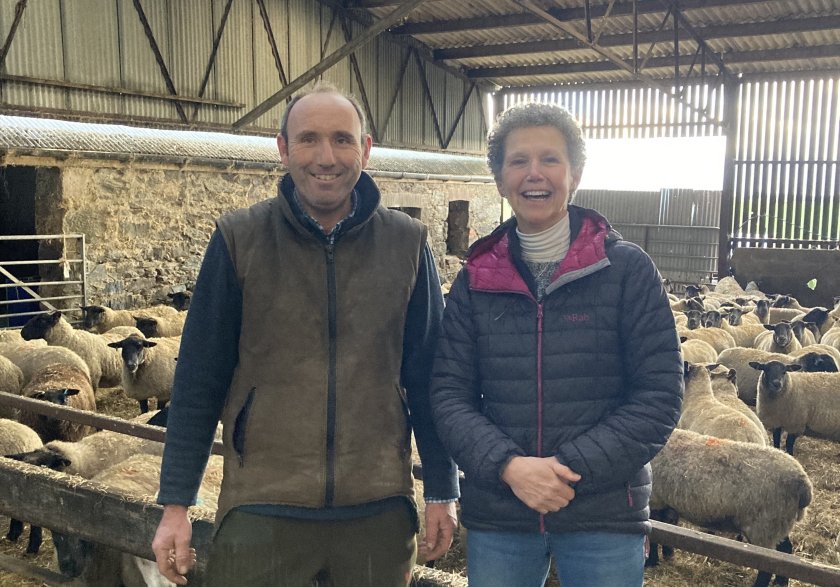
Good quality forages fed in a total mixed ration (TMR) can substantially reduce the need to feed concentrates to pregnant ewes, a Welsh farming family say.
The principle of optimising the contribution from forage to allow minimal supplementation is one that the Foulkes aim for at Marchynys, a 700-acre farm on Anglesey where they lamb 2,700 ewes from the end of January.
During a recent event at the farm, independent sheep specialist Kate Phillips, who has been formulating the farm’s pregnant ewe ration for many years, advised farmers to get forages analysed.
Without knowing their nutrient content, it isn’t possible to get the right balance in the diet, she said at the event, which was run by Farming Connect.
An analysis will indicate how much additional feed is needed to fill any nutritional shortfalls in the forage.
But Mrs Phillips had words of caution too: “If the analysis doesn’t match up with your observations of the crop, for instance if the cutting conditions were good and the crop was at the right stage for harvesting but that isn’t reflected in the analysis, get it checked again."
At Marchynys, ewe diets include grass silage, maize silage, barley treated with Hom n’ Dry (a urea and soya pellet), molasses, rapeseed meal, Ultrasoy and minerals.
This year, as a result of a delay to harvesting, the nutrient values were lower than usual with the clamp silage analysing at 9.9 ME (MJ/kgDM), 11.3% crude protein and 40.5% dry matter (DM) and the baled silage at 9.3% ME, 12.8% crude protein and 42.9% DM.
For the homegrown maize, those values were 10.8 ME, 8.8% crude protein and 44.7%DM.
Mrs Phillips said, although feed costs were down on last year’s very high prices, farmers should always make the most of their homegrown ingredients.
“Work out what you have got on-farm first and then only buy the feed you need to balance that," she said.
Feeding TMR at Marchynys means ewes get a constant diet throughout the day so there are none of the large shifts in rumen pH associated with feeding meals of concentrates on their own.
The ration can be formulated to meet the needs of ewes at different stages of their pregnancy, with minimal changes in the diet.
The Foulkes’ introduce the feed to some ewes seven weeks before they lamb but this depends on when the animals are housed.
Mrs Phillips formulates the rations for an 80kg ewe at body condition score 3 - 3.5.
She predicts the weight of forage they will eat but said it is important to monitor intakes to establish if they match the dry matter intake predicted.
“Weigh what the ewes are eating, let the ewes settle on the diet for a week and then check that the quantities tie in with predicted intakes," she said.
“They might be eating 0.5 kg more or 0.5kg less of fresh forage and if that is the case tweak the diet to get the right balance."
The pre-lambing ewe diet is important for many reasons; it drives colostrum quality and milk production without drawing condition from the ewe.
As well as a diet feeder, farmers considering TMR must have a building suitable for this type of feeding – a building that has feed passages and can be accessed with a machine.
At Marchynys, pregnant yearling ewes are housed in a roofless slatted unit which accommodates 650 sheep and was built on a sheltered site without a roof, not as a cost saving measure, but to preserve pasture for early spring grazing and to support flock health.
The animals don’t experience the respiratory problems associated with poorly ventilated sheds and foot health is very good because the sheep are standing on slats and their feet are dry.
Yearlings previously grazed a 120-acre block until mid-February, but, as the farm is in a high rainfall area, the land was heavily poached and grass growth didn’t properly recover until at least June.
Housing more of the flock from the end of November was an option but a conventional housed system was not suitable because of the length of time the sheep would need to be indoors.
The solution was to build a 150 x 30 feet roofless unit, divided into five pens with floors of plastic slats. It was sited next to the farmyard in a sheltered position close to other sheds.
Yearlings are housed in it from the end of November to the end of February. It is earmarked for this group of animals because they are the last to lamb and therefore need to be housed the longest.
They are on the slats for two and a half months before they are moved into the lambing shed a month before lambing. Triplets are drawn out first, followed by the twins and finally the singles.
